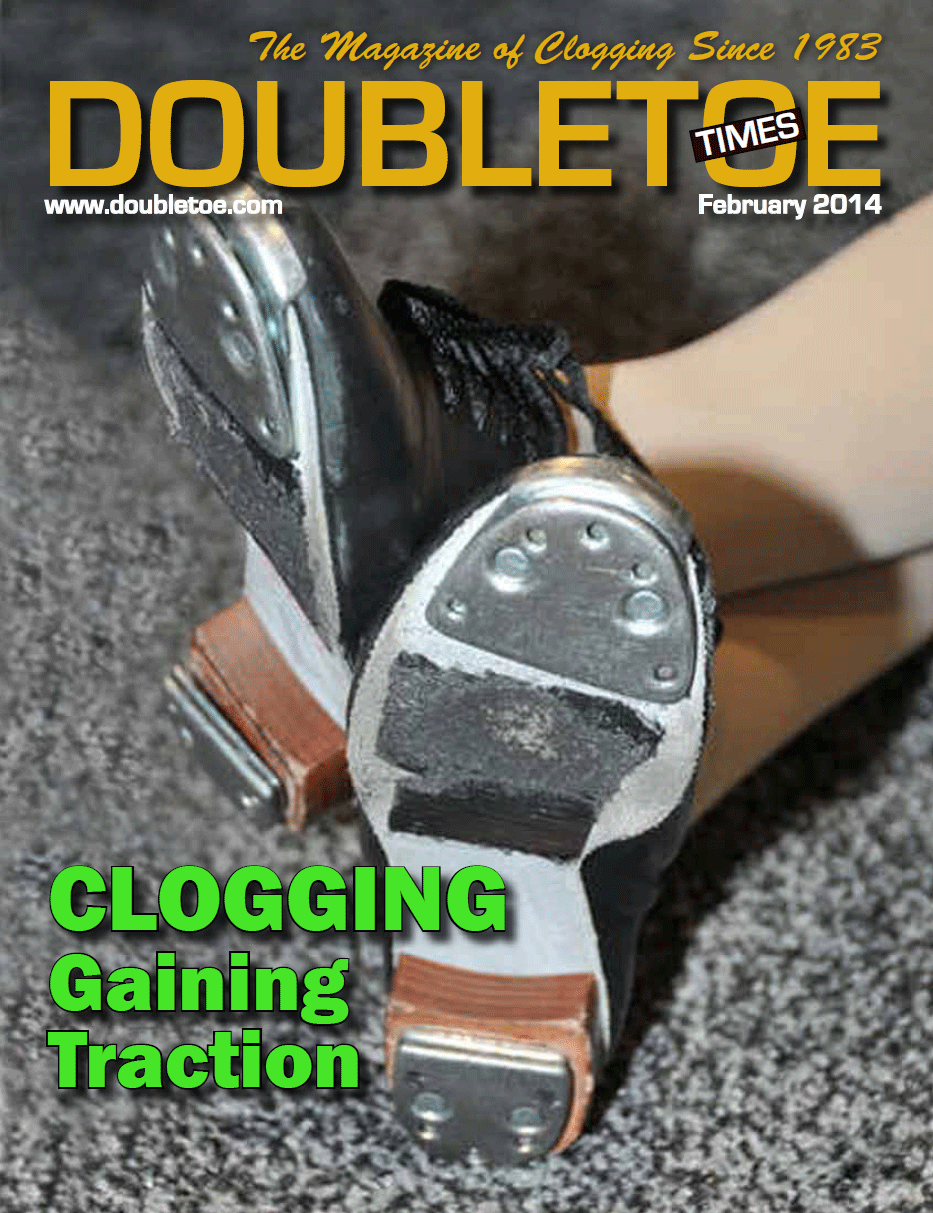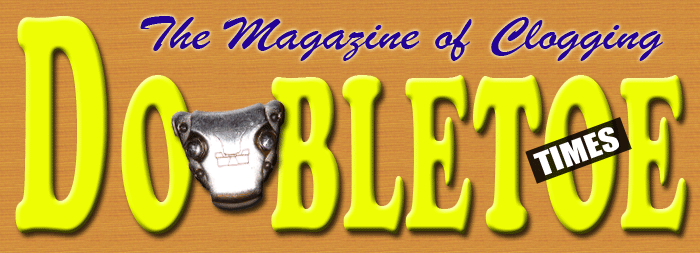 |
 |
|
DOUBLE TOE TIMES SPONSORED EVENTS DOUBLE TOE TIMES SECURE ONLINE STORE |
The Basic Steps of Cloggingby Jeff Driggs How to Get Started
Appalachian clogging is a rhythmic dance that accompanies the downbeat, or bass beat, of the music. Take a moment to listen to a hoe-down song and tap your feet or clap your hands to the downbeat of the music.
Starting with your left foot, begin stepping in place to the downbeat of the music. Don't march, just relax and step comfortably to the music as if you are a part of it. Now add a kick to your step. Keep stepping on tl1e downbeat, but let your feet come out in front of you and kick forward before you step -like a tin soldier. but less rigid.
KICK STEP KICK STEP KICK STEP KICK STEP L L R R L L R R & 1 & 2 & 3 & 4
You 're seeing this sequence as it would be written on a "Cue Sheet". A cue sheet is a diagram of the steps and timing of a step or dance. The words or abbreviations on the top line explain the foot movement, the L & R tell you on which foot you perform the movement, and the numbers along tile bottom tell you on which beat of the music you will perform tile step. \\r e will learn more about cue sheets and movement notations as we go along. Cue sheets will become very important tools in remembering steps and learning new dances as you become more confident in your clogging.
Now kick forward with the left foot, then step in place three times, like the cue below describes:
KICK STEP STEP STEP L L R L & 1 & 2
It's simple, just think KICK I, 2, 3… Kick and three steps. Remember that the first step will occur on the downbeat -or bass beat - of the music. Practice the step a few times to get the feel of it, then try KICK 1,2,3 on the right foot. Now alternate feet and practice with some slow music with a steady beat. KICK 1.2.3... KICK 1.2.3... Relax and feel the music.
You've just learned the beginning of the BASIC STEP of clogging!
The Double-Toe
The double-toe sound is what will really make you feel like you're clogging. It's really pretty simple. I've heard people explain the double- toe sound as "kicking a rock" or "getting the gum off of your shoe". We're going to take a little looser approach to the double-toe sound.
Let's go back to the KICK STEP that you already know. As you do this, your foot comes forward with the kick and then steps down. We're going to turn this kick into a double-toe.
Standing on your right foot, relax your left toe and bring your foot forward - letting your toe brush the floor as it goes forward and making a sound. Now let your toe fall back to the floor, making a second sound. This is a DOUBLE-TOE. Brush, Fall = Double-Toe. Now that your foot has done a double-toe, step on the left foot and get your right foot free. Repeat the same action on your right foot. Brush the toe forward and let it fall, then step. You've just done a DOUBLE-TOE STEP.
DOUBLE- TOE STEP DOUBLE- TOE STEP L L R R &a 1 &a 2
Now try it with the music. A good way to get started is to go back to the KICK STEP, KICK STEP. Keep going and establish the beat. Now as you kick out, relax your toe and let it brush the floor as you kick and bring it back. This will allow you to double-toe in place of the kick.
The Basic Step
Now that you've lean1ed the Double-Toe Step, let's add two more steps to it:
DOUBLE- TOE STEP STEP STEP L L R L &a 1 & 2
A great way to work into this is to return to KICK 1, 2, 3 and slowly add the double-toe in place of the kick.
PRACTICE, PRACTICE, PRACTICE!
Now let's learn how to style the step. Get up on tIle balls of your feet. Step with your left foot, tllen put your right foot back just a little and rock your weight back onto it, tllen step on your left foot again.
STEP ROCK STEP L R L 1 & 2
The STEP ROCK STEP is the same as the three steps in KICK 1, 2, 3
The big leap… put it all together!
DOUBLE- TOE STEP ROCK STEP L L R L &a 1 & 2
Try alternating feet. You are now doing the BASIC STEP of clogging!
Remember, if you're having trouble, always go back to the simplest form and build on it. Start with a KICK I, 2, 3 then add the DOUBLE- TOE in place of the kick, ROCK back on the 2nd step of 1,2,3 and you've got it!
More Basics, Clogging Terminology, And More Stuff to Confuse and Challenge You!
Now that you are beginning to feel comfortable the BASIC STEP, let's use the foot movements you already know to learn a TRIPLE and a FANCY DOUBLE.
First, let's learn a few abbreviations to make things easier.
The abbreviation in clogging for a DOUBLE-TOE is: DT or just D The abbreviation in clogging for a STEP is: S The abbreviation in clogging for a ROCK is: R
Let's take a little test... Knowing what you do about the BASIC STEP of clogging, think of what the abbreviation for DOUBLE- TOE STEP ROCK STEP would be.
Scroll down to check the answer.
V V V V V V V V
If you thought DT S R S or D S R S then you're exactly right!
When a DOUBLE- TOE and STEP are done together, they are often abbreviated as DTS or even DS.
The TRIPLE and FANCY DOUBLE
Now, using the abbreviations we've just learned, to follow are the cues for a TRIPLE and a FANCY DOUBLE.
Triple DS DS DS R S L R L R L &1 &2 &3 & 4
Fancy Double DS DS R S R S L R L R L R &1 &2 & 3 & 4
BRUSHES
A BRUSH in clogging is the brushing of the ball of the foot in any given direction.
Let's learn a BRUSH UP. Stand on your left foot. With your right knee straight, brush the ball of your right foot forward. Now bend your right knee and bring your right leg up - keeping the lower leg parallel to the left leg.
Try it again. Stand on your left foot. Take your right foot and BRUSH UP. Keep your knee straight on BRUSH and bend it when the foot comes UP .
DS BR UP L R R &1 & 2
PRACTICE, PRACTICE, PRACTICE!
Even More Stuff to Confuse and Challenge You
Because clogging is such a diverse dance with so many difference styles and influences, it has been difficult for teachers to agree on a single format for terminology and cue sheets. What may be called a BRUSH UP in one area of the country may be called a CHUG in another, and a PUMP or LIFT in yet another. Many different groups and individuals have worked to standardize movement names and terminology to make it easier for clogging to be learned and shared. Sheila Popwell, a clogging instructor and innovator during the 70's and early 80's was very instrumental in helping to establish standardized abbreviations for use in teaching and cueing. Listed below are the movements and abbreviations we will be utilizing for this internet learning session.
DOUBLE-TOE DT STEP S DOUBLE-TOE STEP DS ROCK R BRUSH BR
Directional Abbreviations
Directional abbreviations follow a step notation in abbreviation form and gives the direction in which the foot movement is to take place. It is usually placed in parentheses just after the movement, i.e. S (XIF) FRONT (F) BACK (B) ACROSS IN FRONT (XIF) ACROSS IN BACK (XIB) OUT TO THE SIDE (OTS)
More Steps to Try
Many steps in clogging are built by putting steps together. A good example is a ROCKIN' CHAIR. Starting on the left foot, do a DOUBLE- TOE STEP and BRUSH UP with the right, then on the right foot do a BASIC STEP.
ROCKIN’ CHAIR DS BR UP DS R S L R R R L R &1 & 2 &3 & 4
If you look at the motion of your body as you do this step, you’ll see why it is called a ROCKIN' CHAIR.
Here are some more steps to try:
CHAIN ROCK
DS R S R S R S L R L R L R L &1 & 2 & 3 & 4
CLOGOVER VINE
DS DS(XIF) DS DS(XIB) DS DS(XIF) DS R S L R L R L R L R L &1 &2 &3 &4 &5 &6 &7 & 8
|




